 | | | Switch to: Europe, USA, New Zealand, Antarctica Credit: NOAA/Ovation  Planetary K-index Planetary K-index
Now: Kp= 2 quiet
24-hr max: Kp= 3 quiet
explanation | more data
Interplanetary Mag. Field
Btotal: 6.9 nT
Bz: 4.7 nT north
more data: ACE, DSCOVR
Updated: Today at 2345 UT  Coronal Holes: 16 Apr 22 Coronal Holes: 16 Apr 22 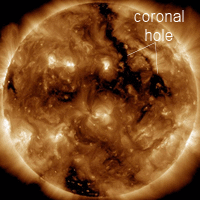
Solar wind flowing from this coronal hole should reach Earth on April 17-18. Credit: SDO/AIA  Noctilucent Clouds Noctilucent Clouds
The southern season for noctilucent clouds is over. It ended on Feb. 20, 2022, concluding the weakest NLC season in 14 years. The northern season will begin in late May.. Switch view: Ross Ice Shelf, Antarctic Peninsula, East Antarctica, Polar Updated at:  SPACE WEATHER
NOAA Forecasts | | Updated at: 2022 Apr 16 2200 UTC FLARE | 0-24 hr | 24-48 hr | CLASS M | 60 % | 60 % | CLASS X | 05 % | 05 % |  Geomagnetic Storms: Geomagnetic Storms:
Probabilities for significant disturbances in Earth's magnetic field are given for three activity levels: active, minor storm, severe storm Updated at: 2022 Apr 16 2200 UTC Mid-latitudes | 0-24 hr | 24-48 hr | ACTIVE | 30 % | 30 % | MINOR | 10 % | 10 % | SEVERE | 01 % | 01 % | High latitudes | 0-24 hr | 24-48 hr | ACTIVE | 15 % | 15 % | MINOR | 25 % | 25 % | SEVERE | 40 % | 40 % | | | |  | | | | | | | | | | | Never miss another geomagnetic storm. Sign up for Space Weather Alerts and you'll receive a text message when magnetic storms erupt. Aurora your guides and professional astronomers use this service. You can, too! | | | THE BIG SUNSPOTS HAVE ARRIVED: An active sunspot group is emerging over the sun's northeastern limb. There are at least two dark cores larger than Earth, with a possibility of more spots trailing behind. This sunspot group has been very active, hurling CMEs and plumes of plasma over the edge of the sun. Future explosions may be Earth-directed. Solar flare alerts: SMS Text
MORNING PLANETS: Something big is about to happen in the pre-dawn sky. Right now, the brightest planets in the Solar System are aligning ahead of a dazzling conjunction between Venus and Jupiter at the end this month. Paolo Bardelli photographed the planetary sprawl before sunrise on April 16th from Sumirago, Italy: 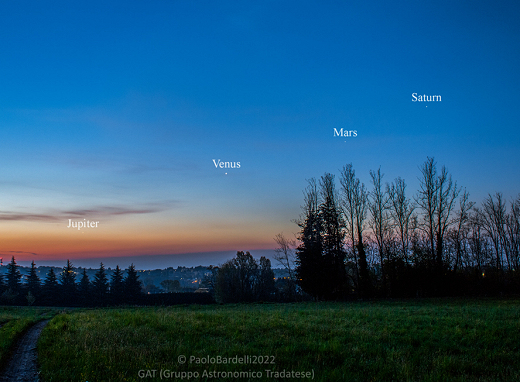
"The four planets were aligned almost perfectly," says Bardelli. "Jupiter is still immersed in the mist, but visible, despite its low height above the horizon." This arrangement will change rapidly in the mornings ahead. Jupiter will lift itself out of the mist as it converges with Venus for the finest conjunction of 2022. On April 30th and May 1st, the two planets will be only 0.2 degrees apart. Visually, they may seem to merge into a single bright object. Only a few days earlier, on April 27th, the crescent Moon will join the planets to form a magnificent triangle in the pre-dawn sky. Set your alarm and enjoy the show! Sky maps: April 23, 24, 25, 26, 27, 28, 29, 30, May 1. Realtime Space Weather Photo Gallery
Free: Spaceweather.com Newsletter OCEAN BLUE CRYSTAL DOLPHIN PENDANT: Are you looking for a far-out gift? Consider the Ocean Blue Crystal Dolphin Pendant. On April 8th, it flew to the stratosphere onboard a cosmic ray research balloon: 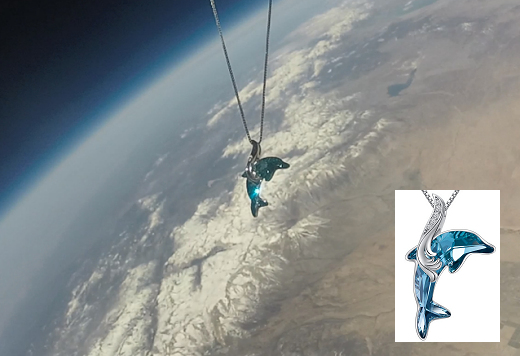
You can have it for $172.95. The students of Earth to Sky Calculus are selling these crystal cetaceans to support their cosmic ray monitoring program. The dolphin is wrapped in a sterling silver wave and suspended from a matching 18-inch chain. It contains no nickel, no lead, no cadmium; the pendant is totally hypoallergenic. Each pendant comes with a greeting card showing the dolphin in flight, and telling the story of its trip to the edge of space and back again. Far Out Gifts: Earth to Sky Store
All sales support hands-on STEM education
Realtime Aurora Photo Gallery
Free: Spaceweather.com Newsletter Every night, a network of NASA all-sky cameras scans the skies above the United States for meteoritic fireballs. Automated software maintained by NASA's Meteoroid Environment Office calculates their orbits, velocity, penetration depth in Earth's atmosphere and many other characteristics. Daily results are presented here on Spaceweather.com. On Apr 16, 2022, the network reported 10 fireballs.
(10 sporadics) 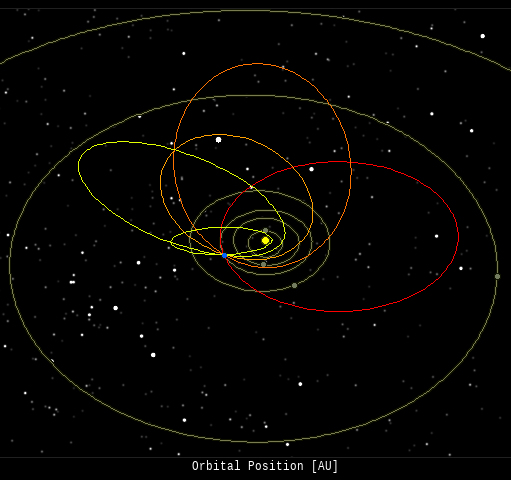 In this diagram of the inner solar system, all of the fireball orbits intersect at a single point--Earth. The orbits are color-coded by velocity, from slow (red) to fast (blue). [Larger image] [movies] Potentially Hazardous Asteroids ( PHAs) are space rocks larger than approximately 100m that can come closer to Earth than 0.05 AU. None of the known PHAs is on a collision course with our planet, although astronomers are finding new ones all the time. On April 16, 2022 there were 2275 potentially hazardous asteroids.
 | Recent & Upcoming Earth-asteroid encounters: | Asteroid | Date(UT) | Miss Distance | Velocity (km/s) | Diameter (m) | | 2022 GG3 | 2022-Apr-11 | 1.5 LD | 11.4 | 6 | | 363599 | 2022-Apr-12 | 19.3 LD | 24.5 | 218 | | 2022 GU2 | 2022-Apr-12 | 4.8 LD | 11.8 | 18 | | 2022 GD3 | 2022-Apr-12 | 8.1 LD | 8.6 | 40 | | 2022 GP3 | 2022-Apr-13 | 17.1 LD | 7.5 | 17 | | 2022 GM4 | 2022-Apr-13 | 1.5 LD | 23.1 | 13 | | 2022 GS3 | 2022-Apr-13 | 2.8 LD | 9.7 | 51 | | 2022 GL4 | 2022-Apr-14 | 2.9 LD | 13.6 | 15 | | 2022 FR3 | 2022-Apr-14 | 18.3 LD | 8.3 | 92 | | 2022 GR2 | 2022-Apr-16 | 10.4 LD | 26.6 | 71 | | 2022 GG5 | 2022-Apr-16 | 11.7 LD | 10.7 | 25 | | 2022 GL3 | 2022-Apr-16 | 2.1 LD | 5.4 | 13 | | 2022 GX4 | 2022-Apr-17 | 4.3 LD | 16.5 | 25 | | 2020 TQ6 | 2022-Apr-18 | 13.4 LD | 15.4 | 43 | | 2022 GJ4 | 2022-Apr-18 | 3.8 LD | 15.6 | 19 | | 2022 FN3 | 2022-Apr-19 | 15.1 LD | 6.3 | 39 | | 2022 GU3 | 2022-Apr-22 | 4.6 LD | 8.7 | 25 | | 2017 UR2 | 2022-Apr-22 | 19.4 LD | 9.3 | 10 | | 2020 VN1 | 2022-Apr-25 | 19.3 LD | 2.3 | 9 | | 418135 | 2022-Apr-28 | 8.5 LD | 10.4 | 466 | | 2017 XO2 | 2022-May-01 | 18.8 LD | 12.4 | 125 | | 2017 HG1 | 2022-May-04 | 18.2 LD | 6 | 11 | | 467460 | 2022-May-09 | 14.9 LD | 11.3 | 513 | | 2019 JE | 2022-May-11 | 4.9 LD | 7.2 | 20 | | 2012 UX68 | 2022-May-15 | 2.8 LD | 8.2 | 54 | | 388945 | 2022-May-15 | 15 LD | 8.2 | 290 | | 2013 UX | 2022-May-17 | 16.8 LD | 16.3 | 141 | | 2021 WY | 2022-May-18 | 16.9 LD | 9 | 65 | | 7335 | 2022-May-27 | 10.5 LD | 13.1 | 1058 | | 2021 KO2 | 2022-May-30 | 3.1 LD | 14.8 | 9 | | 2020 DA4 | 2022-Jun-01 | 5.5 LD | 8.9 | 26 | | 2021 GT2 | 2022-Jun-06 | 9.5 LD | 7.5 | 50 | | 2018 LU2 | 2022-Jun-09 | 14.8 LD | 10.7 | 16 | | 2006 XW4 | 2022-Jun-12 | 5.9 LD | 7.3 | 49 | Notes: LD means "Lunar Distance." 1 LD = 384,401 km, the distance between Earth and the Moon. 1 LD also equals 0.00256 AU. MAG is the visual magnitude of the asteroid on the date of closest approach. | | Cosmic Rays in the Atmosphere | SPACE WEATHER BALLOON DATA: Almost once a week, Spaceweather.com and the students of Earth to Sky Calculus fly space weather balloons to the stratosphere over California. These balloons are equipped with sensors that detect secondary cosmic rays, a form of radiation from space that can penetrate all the way down to Earth's surface. Our monitoring program has been underway without interruption for 7 years, resulting in a unique dataset of in situ atmospheric measurements. Latest results (Nov. 2021): Our balloons have just measured a sudden drop in atmospheric radiation. It happened during the strong geomagnetic storms of Nov. 3-4, 2021. Here are the data: 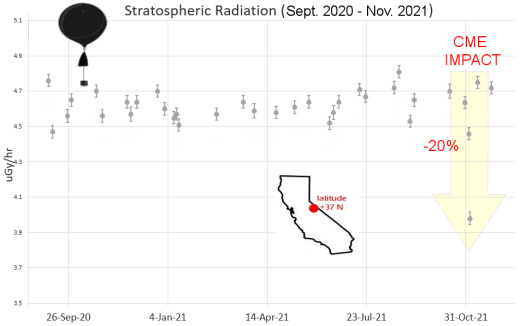
This is called a "Forbush decrease," named after American physicist Scott Forbush who studied cosmic rays in the early 20th century. It happens when a CME from the sun sweeps past Earth and literally pushes cosmic rays away from our planet. Radiation from deep space that would normally pepper Earth's upper atmosphere is briefly wiped out. We have measured Forbush decreases before. For example, here's one from Sept. 2014. The Forbush Decrease of Nov. 3-4, 2021, was the deepest in the history of our 7-year atmospheric monitoring program. Radiation levels in the stratosphere over California dropped nearly 20%, more than doubling the previous record from our dataset. En route to the stratosphere, our sensors also pass through aviation altitudes, so we can sample radiation where planes fly. This plot shows how the Forbush decrease was restricted to the stratosphere; it did not affect lower levels of the atmosphere: 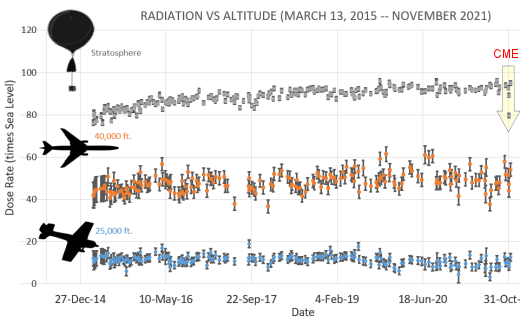
The dose rates shown above are expressed as multiples of sea level. For instance, we see that boarding a plane that flies at 25,000 feet exposes passengers to dose rates ~10x higher than sea level. At 40,000 feet, the multiplier is closer to 50x. The higher you fly, the more radiation you will absorb. .Who cares? Cosmic rays are a surprisingly "down to Earth" form of space weather. They can seed clouds, trigger lightning, and penetrate commercial airplanes. According to a study from the Harvard T.H. Chan school of public health, crews of aircraft have higher rates of cancer than the general population. The researchers listed cosmic rays, irregular sleep habits, and chemical contaminants as leading risk factors. Somewhat more controversial studies (#1, #2, #3, #4) link cosmic rays with cardiac arrhythmias and sudden cardiac death. .Technical notes: The radiation sensors onboard our helium balloons detect X-rays and gamma-rays in the energy range 10 keV to 20 MeV. These energies span the range of medical X-ray machines and airport security scanners. Data points in the first graph ("Stratospheric Radiation") correspond to the peak of the Regener-Pfotzer maximum, which lies about 67,000 feet above central California. When cosmic rays crash into Earth's atmosphere, they produce a spray of secondary particles that is most intense at the entrance to the stratosphere. Physicists Eric Regener and Georg Pfotzer discovered the maximum using balloons in the 1930s and it is what we are measuring today. | | The official U.S. government space weather bureau | | | The first place to look for information about sundogs, pillars, rainbows and related phenomena. | | | Researchers call it a "Hubble for the sun." SDO is the most advanced solar observatory ever. | | | 3D views of the sun from NASA's Solar and Terrestrial Relations Observatory | | | Realtime and archival images of the Sun from SOHO. | | | information about sunspots based on the latest NOAA/USAF Active Region Summary | | | from the NOAA Space Environment Center | | | fun to read, but should be taken with a grain of salt! Forecasts looking ahead more than a few days are often wrong. | | | from the NOAA Space Environment Center | | | the underlying science of space weather |  | Going above and beyond to provide the best homes listings in the Comox real estate market to keep you up to date and informed |  | BestCSGOGambling is the best site for everything related to CSGO gambling on the web |  | To find reviews of new online casino sites in the UK try The Casino DB where there are hundreds of online casino reviews complete with bonuses and ratings. Alternatively, Online-Casinos.xyz is another massive directory of online casinos listing sites for the UK and Worldwide. Casinos that offer Rupees for bonuses are very generous to Indian players. Find the best online casinos in India at AllCasinos.in Looking for a new online casino? Try Casimpo the new site dedicated to making online casino simple, or check out the new Avenger Slots Casino and Ace Online Casino with over 500 online slots and casino games. |  | One of the most popular casino games is the Book Of Dead Slot based on ancient Egyptian text, you can find all the casinos with spins at bookofdeadslotsites.com. |  | When looking for casinos to play online when the weather is bad, you can try casino online trucchi for Italian games. If you are not from Finland you can try the Swedish page Svenska casino online to find suitable games, check out svenskacasinoonline.net. Always check your local laws before playing with real money. |  | Looking for sports betting companies not registered on GamStop? CasinoGap has presented a list of sites not on GamStop available for UK players. Check and bet online! Would you like to bet at sites not using GamStop? Look at a list of NonStopCasino sites for online betting that aren't on GamStop. Top-rated bookmakers ever! | | | These links help Spaceweather.com stay online. Thank you to our supporters! | | | | | | | | |  | |  |   | ©2021 Spaceweather.com. All rights reserved. This site is penned daily by Dr. Tony Phillips. | |

